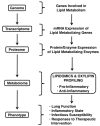Omics approaches in cystic fibrosis research: a focus on oxylipin profiling in airway secretions
- PMID: 22758630
- PMCID: PMC3403728
- DOI: 10.1111/j.1749-6632.2012.06580.x
Omics approaches in cystic fibrosis research: a focus on oxylipin profiling in airway secretions
Abstract
Cystic fibrosis (CF) is associated with abnormal lipid metabolism, intense respiratory tract (RT) infection, and inflammation, eventually resulting in lung tissue destruction and respiratory failure. The CF RT inflammatory milieu, as reflected by airway secretions, includes a complex array of inflammatory mediators, bacterial products, and host secretions. It is dominated by neutrophils and their proteolytic and oxidative products and includes a wide spectrum of bioactive lipids produced by both host and presumably microbial metabolic pathways. The fairly recent advent of "omics" technologies has greatly increased capabilities of further interrogating this easily obtainable RT compartment that represents the apical culture media of the underlying RT epithelial cells. This paper discusses issues related to the study of CF omics with a focus on the profiling of CF RT oxylipins. Challenges in their identification/quantitation in RT fluids, their pathways of origin, and their potential utility for understanding CF RT inflammatory and oxidative processes are highlighted. Finally, the utility of oxylipin metabolic profiling in directing optimal therapeutic approaches and determining the efficacy of various interventions is discussed.
© 2012 New York Academy of Sciences.
Figures



Similar articles
-
Metabolomic profiling of regulatory lipid mediators in sputum from adult cystic fibrosis patients.Free Radic Biol Med. 2012 Jul 1;53(1):160-71. doi: 10.1016/j.freeradbiomed.2012.05.001. Epub 2012 May 8. Free Radic Biol Med. 2012. PMID: 22580336 Free PMC article.
-
Oxidative stress and abnormal bioactive lipids in early cystic fibrosis lung disease.J Cyst Fibros. 2019 Nov;18(6):781-789. doi: 10.1016/j.jcf.2019.04.011. Epub 2019 Apr 26. J Cyst Fibros. 2019. PMID: 31031161
-
Think big - think omics.J Inherit Metab Dis. 2018 May;41(3):281-283. doi: 10.1007/s10545-018-0165-4. J Inherit Metab Dis. 2018. PMID: 29541953 No abstract available.
-
Inflammation in cystic fibrosis: An update.Pediatr Pulmonol. 2018 Nov;53(S3):S30-S50. doi: 10.1002/ppul.24129. Epub 2018 Jul 12. Pediatr Pulmonol. 2018. PMID: 29999593 Review.
-
Physical and functional properties of airway secretions in cystic fibrosis--therapeutic approaches.Respiration. 1995;62 Suppl 1:2-12. doi: 10.1159/000196486. Respiration. 1995. PMID: 7792436 Review.
Cited by
-
An Innovative Protocol for Metaproteomic Analyses of Microbial Pathogens in Cystic Fibrosis Sputum.Front Cell Infect Microbiol. 2021 Aug 27;11:724569. doi: 10.3389/fcimb.2021.724569. eCollection 2021. Front Cell Infect Microbiol. 2021. PMID: 34513734 Free PMC article.
-
Oxylipin profile in saliva from patients with cystic fibrosis reveals a balance between pro-resolving and pro-inflammatory molecules.Sci Rep. 2022 Apr 7;12(1):5838. doi: 10.1038/s41598-022-09618-7. Sci Rep. 2022. PMID: 35393448 Free PMC article.
-
Oxidized fatty acids as inter-kingdom signaling molecules.Molecules. 2014 Jan 20;19(1):1273-85. doi: 10.3390/molecules19011273. Molecules. 2014. PMID: 24448067 Free PMC article. Review.
-
Neonatal Cord Blood Oxylipins and Exposure to Particulate Matter in the Early-Life Environment: An ENVIRONAGE Birth Cohort Study.Environ Health Perspect. 2017 Apr;125(4):691-698. doi: 10.1289/EHP291. Epub 2016 Nov 4. Environ Health Perspect. 2017. PMID: 27814242 Free PMC article.
-
The Postprandial Effects of a Moderately High-Fat Meal on Lipid Profiles and Vascular Inflammation in Alzheimer's Disease Patients: A Pilot Study.J Gen Pract (Los Angel). 2014;2(6):186. doi: 10.4172/2329-9126.1000186. J Gen Pract (Los Angel). 2014. PMID: 26029731 Free PMC article.
References
-
- Rowe SM, Miller S, Sorscher EJ. Cystic fibrosis. N Engl J Med. 2005;352:1992–2001. - PubMed
-
- Downey DG, Bell SC, Elborn JS. Neutrophils in cystic fibrosis. Thorax. 2009;64:81–88. - PubMed
-
- van der Vliet A, Eiserich JP, Marelich GP, Halliwell B, Cross CE. Oxidative stress in cystic fibrosis: does it occur and does it matter? Adv Pharmacol. 1997;38:491–513. - PubMed
-
- Galli F, Battistoni A, Gambari R, Pompella A, Bragonzi A, Pilolli F, Iuliano L, Piroddi M, Dechecchi MC, Cabrini G. Oxidative stress and antioxidant therapy in cystic fibrosis. Biochim Biophys Acta. 2012;1822:690–713. - PubMed
Publication types
MeSH terms
Substances
Grants and funding
LinkOut - more resources
Full Text Sources
Medical

